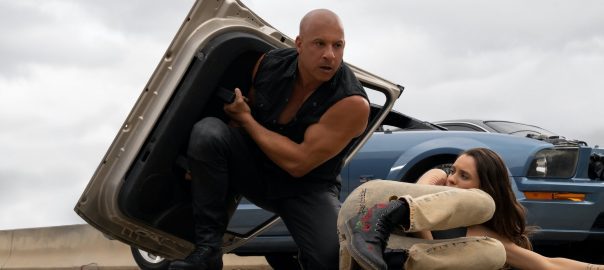Joshua Gulam, Liverpool Hope University; Dr Sarah Feinstein, University of Leeds, and Fraser Elliott, The University of Edinburgh
There’s a scene in the latest Fast & Furious film, Fast X, where Aimes (Alan Ritchson) – the government agent tasked with apprehending Dom (Vin Diesel) and his crew – gives a rundown of the heroes’ backstory:
Let’s start back at the beginning … Los Angeles, 2001 … Humble roots, local kids … Street racers who became hijackers … Graduated to high-speed smuggling, mobile jailbreaks, train robberies … If it could be done in a car, they did it … If it violates the laws of God and gravity, they did it twice.
On one level, the scene is a recap reel. Monitors inside Aimes’ hi-tech HQ play clips from the Fast family’s biggest stunts. These clips are designed to initiate casual viewers into the Furious-verse, helping them to make sense of what’s to come.
On another level, it’s a knowing wink to “ride or die” fans. The scene addresses audiences who’ve followed the franchise throughout its 22-year history, a period in which Fast & Furious has undergone so many transformations that the latest entries can feel unrecognisable from the first film.
When Aimes talks about “humble roots” in Fast X, therefore, he’s also referring to the franchise as a whole. It began with 2001’s The Fast and the Furious, a mid-budget crime film about street racing which featured a cast of relative unknowns.
In the ten sequels that followed before this latest edition, the franchise grew exponentially, rebranding as the Fast Saga and evolving to become a series of star-studded global adventures in the Mission: Impossible mould.
This evolution brought greater commercial risks and rewards. The Fast Saga is one of the top-ten highest grossing film franchises of all time, and Fast X cost an estimated US$340 million (£275 million) to produce.
By now, the franchise’s unlikely trajectory is so well known that recent films have incorporated meta commentary on their own ridiculousness. This is best illustrated in F9’s (2021) running gag where Roman (Tyrese Gibson) wonders whether the heroes may be invincible.
Fast X is the latest pitstop on this journey. It’s a logical extension of the Fast Saga’s illogical, gravity-defying melodrama, where every set-piece and plot twist furthers the extravagant myth of Dom and his family.
Retcons and resurrections
The latest film (the first of two volumes that will draw the Fast Saga to a close) continues the tradition of bringing back fan favourites. This is something the Fast films do with an alarming disregard for narrative coherence. In this sense, Fast X feels like an attempt to rationalise the messy timeline that emerged out of the unusual choices of earlier films.
That timeline began in Fast & Furious (2009) – the confusingly titled fourth film – where the opening sequence revealed the surprise return of Han (Sung Kang), a character who died in the previous instalment, Tokyo Drift (2006).
Han appeared again in Fast Five (2011) and Fast & Furious 6 (2013). A mid-credits scene in the sixth film seemed to confirm Han’s exit by replaying his death and revealing that it was at the hands of new villain, Deckard Shaw (Jason Statham).
The decision to retcon Han’s demise and then fold it into the events of Furious 7 (2015) established a strange chronology where the fourth, fifth and sixth films take place (in story terms) before Tokyo Drift.
The screenwriters have acknowledged this disregard for linear time, joking: “Look, the timeline is … you know … it’s one-two-four-five-six-three-seven, right?”
Since then, Han has been resurrected once more in F9, where it’s revealed that his death in Tokyo was an elaborate hoax. In Fast X, he finally reunites with Shaw, giving Han a chance to get revenge against the man who appeared to kill him four films ago.
An outlaw franchise
With the number of once-dead characters that populate the Fast Saga, viewers could be forgiven for thinking that many of its major plot points are introduced on a whim, dreamed up by co-producer Vin Diesel during interviews. But there’s method in the madness, a consistent inconsistency which has allowed the saga to carve out its own niche.
The seemingly chaotic nature of the Fast Saga’s development is central to its appeal. Reflecting on its unlikely trajectory, critics often observe that the franchise has an off-the-cuff feel. This distinguishes it from more meticulously planned franchises, such as the Marvel Cinematic Universe, where every sequel and spin-off is mapped out years in advance to try to maximise the brand.
This long-term planning can sometimes be a weakness, leaving such franchises less able to adapt to fan responses. In contrast, the Fast Saga has often shown a fleet-footedness in its engagement with audience demands.
After all, Han was only included in the fourth film after test screenings for Tokyo Drift showed he was a hit with fans, while his resurrection in F9 was a direct response to the #Justice4Han campaign that emerged on social media.
With its elaborate plot twists, surprise cameos and callbacks to previous films, Fast X is enjoyed best as a road trip through the franchise’s messy history. It’s a reminder that the franchise’s route to the blockbuster A-list has been unconventional. Like Dom’s family of street racing outlaws, the Fast Saga continues to play by its own rules.![]()
Joshua Gulam, Senior Lecturer in Film, Liverpool Hope University; Dr Sarah Feinstein, Lecturer in Heritage Studies and Cultural Industries, University of Leeds, and Fraser Elliott, Lecturer in Film, Exhibition and Curation, The University of Edinburgh
This article is republished from The Conversation under a Creative Commons license. Read the original article.

